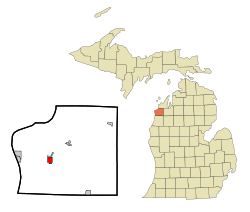Benzonia, Michigan
| Benzonia, Michigan | |
|---|---|
| Village | |
 Location of Benzonia, Michigan |
|
| Coordinates: 44°36′57″N 86°5′57″W / 44.61583°N 86.09917°WCoordinates: 44°36′57″N 86°5′57″W / 44.61583°N 86.09917°W | |
| Country | United States |
| State | Michigan |
| County | Benzie |
| Area | |
| • Total | 1.13 sq mi (2.93 km2) |
| • Land | 1.13 sq mi (2.93 km2) |
| • Water | 0 sq mi (0 km2) |
| Elevation | 817 ft (249 m) |
| Population (2010) | |
| • Total | 497 |
| • Estimate (2012) | 494 |
| • Density | 439.8/sq mi (169.8/km2) |
| Time zone | Eastern (EST) (UTC-5) |
| • Summer (DST) | EDT (UTC-4) |
| ZIP code | 49616 |
| Area code(s) | 231 |
| FIPS code | 26-07580 |
| GNIS feature ID | 2398099 |
Benzonia is a village in Benzie County in the U.S. state of Michigan. The population was 497 at the 2010 census. The village is located within Benzonia Township at the southeast end of Crystal Lake on U.S. Highway 31 at the junction with M-115 west.
According to the United States Census Bureau, the village has a total area of 1.13 square miles (2.93 km2), all land.
Benzonia began in 1858 as an educational Christian colony on the model of Oberlin, Ohio. Its founding was under the leadership of Charles E. Bailey. The village, which was once the county seat, was incorporated in 1891.
In 1863 Grand Traverse College was chartered and began here. It was renamed Benzonia College in 1891. In 1900 the college was changed to a preparatory school named Benzonia Academy. The academy continued to function until 1918 when it was closed. In his book "Waiting for the Morning Train," historian Bruce Catton captured local history and documented his perspective of growing up in Benzonia as his father was an instructor at the academy.
As of the census of 2010, there were 497 people, 209 households, and 125 families residing in the village. The population density was 439.8 inhabitants per square mile (169.8/km2). There were 275 housing units at an average density of 243.4 per square mile (94.0/km2). The racial makeup of the village was 93.2% White, 1.2% African American, 0.4% Native American, 2.4% from other races, and 2.8% from two or more races. Hispanic or Latino of any race were 6.2% of the population.
...
Wikipedia
